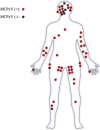Evaluating CK20 and MCPyV Antibody Clones in Diagnosing Merkel Cell Carcinoma
- PMID: 39841326
- PMCID: PMC11754318
- DOI: 10.1007/s12022-024-09845-w
Evaluating CK20 and MCPyV Antibody Clones in Diagnosing Merkel Cell Carcinoma
Abstract
Merkel cell carcinoma (MCC) is diagnosed through histopathological and immunohistochemical examination of biopsies from skin or other organs. Its distinguishing features include perinuclear dot-like staining with Cytokeratin 20 (CK20) and detection of Merkel cell polyomavirus (MCPyV) using various methods. However, CK20 and MCPyV negative MCC cases have been reported at varying rates. In this single center cross-sectional study, we aimed to determine which clones are more effective in diagnosing MCC by comparing the performance of CK20 antibody clones Ks20.8 and SP33, as well as MCPyV antibody clones Ab3 and CM2B4. Fifty-four patients diagnosed with MCC were included. Among these, 42 cases were primary cutaneous, and 12 cases were nodal MCC. Fifty-two (96.3%) cases were positive with both CK20 clones, while two cases were negative. Clone SP33 stained areas of necrosis, whereas Ks20.8 showed no aberrant staining. MCPyV was detected in 44 cases (81.5%) using clone Ab3 and 39 cases (72.2%) using clone CM2B4. Staining with MCPyV clone Ab3 was diffuse and strong in most cases, while approximately 30% of CM2B4-positive cases exhibited low percentages and/or weak staining, complicating the evaluation. The two CK20-negative cases were also negative with both MCPyV clones. Our data demonstrated that CK20 clone Ks20.8 may be preferred for MCC diagnosis due to its consistent performance and lack of aberrant staining. Similarly, MCPyV clone Ab3 appears superior to CM2B4 for identifying MCPyV-positive cases.
Keywords: Clone Ab3; Clone CM2B4; Cytokeratin 20; Merkel cell carcinoma; Merkel cell polyomavirus.
© 2025. The Author(s).
Conflict of interest statement
Declarations. Ethics Approval: The study was approved by the Institutional Review Board at Istanbul Faculty of Medicine, Istanbul University. Competing Interests: The authors declare no competing interests.
Figures




Similar articles
-
A monoclonal antibody against SV40 large T antigen (PAb416) does not label Merkel cell carcinoma.Histopathology. 2018 Jul;73(1):162-166. doi: 10.1111/his.13483. Epub 2018 Apr 19. Histopathology. 2018. PMID: 29430700 Free PMC article.
-
Usefulness of significant morphologic characteristics in distinguishing between Merkel cell polyomavirus-positive and Merkel cell polyomavirus-negative Merkel cell carcinomas.Hum Pathol. 2013 Sep;44(9):1912-7. doi: 10.1016/j.humpath.2013.01.026. Epub 2013 May 10. Hum Pathol. 2013. PMID: 23664542
-
The prevalence of Merkel cell polyomavirus in Japanese patients with Merkel cell carcinoma.J Dermatol Sci. 2013 May;70(2):99-107. doi: 10.1016/j.jdermsci.2013.02.010. Epub 2013 Mar 6. J Dermatol Sci. 2013. PMID: 23517683
-
Merkel Cell Carcinoma Case Reports With Merkel Cell Polyomavirus Test and Review of the Literature.Am J Dermatopathol. 2024 Nov 1;46(11):784-787. doi: 10.1097/DAD.0000000000002837. Epub 2024 Sep 17. Am J Dermatopathol. 2024. PMID: 39288754 Free PMC article. Review.
-
Merkel cell polyomavirus and non-Merkel cell carcinomas: guilty or circumstantial evidence?APMIS. 2020 Feb;128(2):104-120. doi: 10.1111/apm.13019. Epub 2020 Jan 28. APMIS. 2020. PMID: 31990105 Review.
References
-
- WHO Classification of Tumours Editorial Board (2023) Skin tumours [Internet; beta version ahead of print]. International Agency for Research on Cancer, Lyon (France)
-
- Youlden DR, Soyer HP, Youl PH, Fritschi L, Baade PD (2014) Incidence and survival for Merkel cell carcinoma in Queensland, Australia, 1993-2010. JAMA Dermatol 150:864-72. 10.1001/jamadermatol.2014.124 - PubMed
-
- Fitzgerald TL, Dennis S, Kachare SD, Vohra NA, Wong JH, Zervos EE (2015) Dramatic increase in the incidence and mortality from Merkel cell carcinoma in the United States. Am Surg 81:802-6. 10.1177/000313481508100819 - PubMed
-
- van-der-Zwan JM, Trama A, Otter R, Larranaga N, Tavilla A, Marcos-Gragera R, et al. (2013) Rare neuroendocrine tumours: results of the surveillance of rare cancers in Europe project. Eur J Cancer 49:2565-78. 10.1016/j.ejca.2013.02.029 - PubMed
-
- Reichgelt BA, Visser O (2011) Epidemiology and survival of Merkel cell carcinoma in the Netherlands. A population-based study of 808 cases in 1993-2007. Eur J Cancer 47:579-85. 10.1016/j.ejca.2010.11.002 - PubMed
MeSH terms
Substances
LinkOut - more resources
Full Text Sources
Medical

